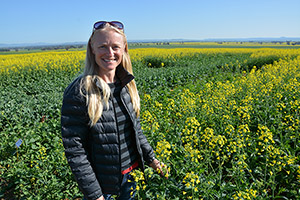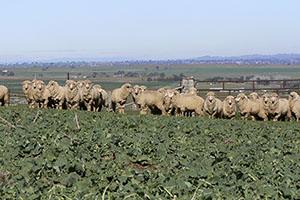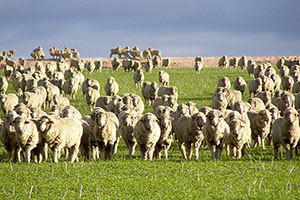Paddock Practices: Balancing the risks and benefits of dual-purpose cropping
Paddock Practices: Balancing the risks and benefits of dual-purpose cropping
Author: Rachael Oxborrow | Date: 11 Jan 2018

CSIRO’s Dr Susie Sprague advises careful timing when considering grazing crops as there is an important balance between losing yields and maintaining crop biomass.
Planting dual-purpose crops can minimise farm risk and increase crop returns by up to $600 per hectare by taking advantage of grazing opportunities in autumn and early spring.
Well-timed early sowing and grazing results in little impact on yield as long as biomass is maintained above critical levels.
The GRDC has been investing in this space for several years, with CSIRO Agriculture & Food examining both canola and wheat varieties to identify ways of optimising grain yield and grazing potential.
CSIRO Agriculture & Food research scientist Dr Susie Sprague says while grazing wheat has been a long-time practice, grazing canola is still a relatively new concept and is slightly harder to manage.
“People are a bit more comfortable with grazing wheat than canola, particularly with the timing of removing stock depending on growth stage,” she says.
“Dual-purpose crops require a bit of a changed mentality around sowing timing in terms of looking at earlier sowing times and hitting flowering windows to manage the paddock right to maximise yield.
“To get the best benefit out of grazing, it’s best to have a plan in place for how the season needs to play out, and if that doesn’t work, don’t graze it.
“For example, if it’s a dry year and there hasn’t been enough rain to build biomass then you wouldn’t graze it, but if you’re having a good year then the crop may not need all of the biomass to achieve good yield and that is when you would consider grazing it.”
Dr Sprague says in addition to the seasonal conditions, livestock numbers also play a part in deciding to graze a paddock.
“In terms of paddock selection, you would need to be thinking about how it sits in with your livestock in terms of time of grazing,” she says.

Research into grazing canola is still in early stages compared to wheat grazing, however the crop presents some useful gains in terms of feed and yield if managed correctly.
“If you haven’t got enough animals then you might get uneven grazing of your crop and you may need to consider buying in stock or agisting for neighbours.”
Practice change around dual-purpose crops starts over summer where sowing two to three weeks earlier will require planned summer weed control. Application of chemicals requires careful assessment so that with-holding periods are met prior to grazing. . Dr Sprague says most commercial wheat and canola varieties can be successfully managed for dual-purpose use. But best results are from early-sown, mid to late maturing types, depending on the district, with high early vigour and for canola, a high blackleg resistance rating.
Selecting a paddock with stored soil moisture should also be a consideration, allowing for a smoother early sowing process where crops can establish well following a rainfall event. Dr Sprague says some growers are taking the practice further than just sowing earlier in March or April and getting useful grazing opportunities over summer by sowing in spring.
“In the high rainfall systems the normal sowing time for them can have waterlogging issues, so being able to sow in spring alleviates the risk and gives them extra grazing at a time where feed can be hard to come by,” she says.
Flexibility in the decision to graze is necessary as the ultimate goal for managing dual-purpose crops is to maximise the profit from the combined income generated by the grazed forage and the grain. This requires an understanding of how grain yield is affected by heavier or delayed grazing and appropriate timing of lock-up from stock.

A flexible approach to grazing wheat with consideration for lock up timing can increase crop returns by up to $600 per hectare.
Studies by Dr Sprague and her colleagues have shown the time of lock up and remaining biomass levels are critical factors that can affect yield. They have defined the grazing window into safe, sensitive and unsafe as seen in Figure 1. The early and ‘safe’ grazing period is once the crop is well anchored and there is still plenty of time for recovery after a period of grazing, even if the crop is grazed quite heavily.
The late and ‘unsafe’ period is when the reproductive parts of the crop (spikes in wheat, or buds in canola) are elongating above the ground, and can be removed by stock. At this stage, there is too little time for the crop to recover enough biomass by anthesis or flowering to set a reasonable yield potential. Most growers can easily identify these two periods by testing crop anchorage to start grazing and checking crop development stage to stop grazing.
The ‘sensitive’ period is the time when the crop has not yet begun to elongate, but where yield recovery can be very sensitive to the amount of residual biomass left. This is the period where some idea of how much residual biomass is needed to reach a specified target grain yield can assist growers with lock-up decisions to avoid yield loss while maximising grazing potential.

Figure 1: Yield recovery (% of un-grazed crop) of grazed dual-purpose crops highlighting the safe, sensitive and unsafe periods of grazing. Yield recovery from grazing during the sensitive period for a given target yield is affected by the residual biomass at lock-up. Late grazing reduces the time for recovery, so more residual biomass is needed.
The general rule of thumb established through the research specifies 1.5 t/ha of residual biomass in spring canola and more than 2.5 to 3t/ha of residual biomass for winter canola at stem elongation for 2.5 - 3.5t/ha grain yield. The results also suggest leaving more than 0.5t/ha residual biomass at stem elongation - growth stage 30 (GS30) - for spring and winter wheat is sufficient to achieve 4 - 5t/ha grain yield.
According to Dr Sprague, while the grazing guidelines for both canola and wheat are similar, there are risk and economic considerations that are quite different.
“Canola is a riskier crop and on top of that, inputs and seed costs are higher,” she says.
“This is particularly the case with the hybrid winter types that make grazing possible with a higher biomass, but are more expensive in terms of seed.
“But all of these risks can be mitigated as long as you’re aware of them.”
Dr Sprague says the reduction in risk of failed or poor yielding crops is the trade that makes dual-purpose cropping attractive. Figures determined from research in New South Wales indicate the gross margin returns achieved by growers from in dual-purpose wheat and canola in southern NSW (Table 1).
However, Dr Sprague says it is important to base variety selection on local results, which is why she advises farmers consult their agronomist for advice.
| Crop type | Grazing achieved (DSE.days/ha) | Grain yield (t/ha) | Paddock $GM increase above grain only |
|---|---|---|---|
| Winter wheat | 1600-2700 | 4.5-6.5 | +$600-$1000 |
| Spring wheat | 400-800 | 3.0-5.0 | +$300-$500 |
| Winter canola | 750-2500 | 2.0-4.0 | +$600-$1000 |
| Spring canola | 300-700 | 1.5-2.5 | +$300-$500 |
The calculations around feed values vs grain value for the operation can dictate grazing timing throughout the growth of the crop, where yield penalties could be an acceptable trade off when feed is being used to fatten or finish lambs or cattle. This is in contradiction to grazing by crop phenology indicators, but demonstrates farming for profitability across the whole enterprise.
A few tips for success with grazing crops
- First time? Get good agronomic advice and plan well ahead
What is your livestock plan to make money from the extra winter feed? - Select a suitable paddock and be prepared to sow early
Weed control, withholding periods, stubble management, stored water for early-sown crops. - Sow early with the right crop and variety – several options available
Winter wheats in March, long-season springs wheats in mid-April, spring wheat late-April. Winter canola types in March, spring hybrid types from mid-April. Select vigorous canola varieties (hybrids) with good blackleg resistance (>R-MB). - Protect early-sown crops from establishment pests and aphids that transmit virus
Seed dressings are affordable and effective, but follow-up aphid sprays in warm autumns may be required if aphids persist. - Aim for a good plant population for good early biomass production for grazing
150 plants/m2 for wheat; 40 plants/m2 for canola. - Ensure sufficient N up-front for good early biomass production
100-150kg/N for winter wheats and canola; 50-100kg/ha for spring wheats and canola. - Don’t graze too early as crops are building root mass and can be checked
Twist and pull test – usually need at least 1.5t/ha biomass (6-8 leaf stage in canola). Recovery and winter growth of canola is slower than cereals. Graze canola once for longer as animals take some time to adjust (at least two weeks grazing). - Animal health issues
Take usual precautions for bloat and nitrate poisoning as usual for palatable feed. Don’t fertilise with N close to grazing, apply upfront and post-grazing. Sodium/magnesium (Na/Mg) supplements required for grazing wheat to maximise live-weight gain. For canola take usual Brassica precautions; cattle are more sensitive than sheep. - Grazing management
Stocking rates around 1,000kg/ha live-weight work well, but adjust to feed on offer. Animals take time to adjust to feed and do best if grazed for longer – avoid frequent change. - Lock-up time is key!
Remove stock before DC30 in wheat and bud elongation in canola. If grazing later, ensure grazing does not remove reproductive parts. - Top-dress N after grazing to assist yield recovery
Assume wheat needs to see 40kg N/ha for every 1t/ha of yield and canola 80kg N/ha - and adjust topdressing according to existing N and target yield.
From Managing dual-purpose crops to optimise profit from grazing and grazing and grain yield.
More information
Susie Sprague
CSIRO Agriculture
GPO Box 1600, Canberra ACT 2601
02 6246 5387; 0466 643 227
Susan.Sprague@csiro.au
Useful resources
GRDC Project Code: FLR00005, CWF00013, CSP00111, CSP1306-003RTX,
